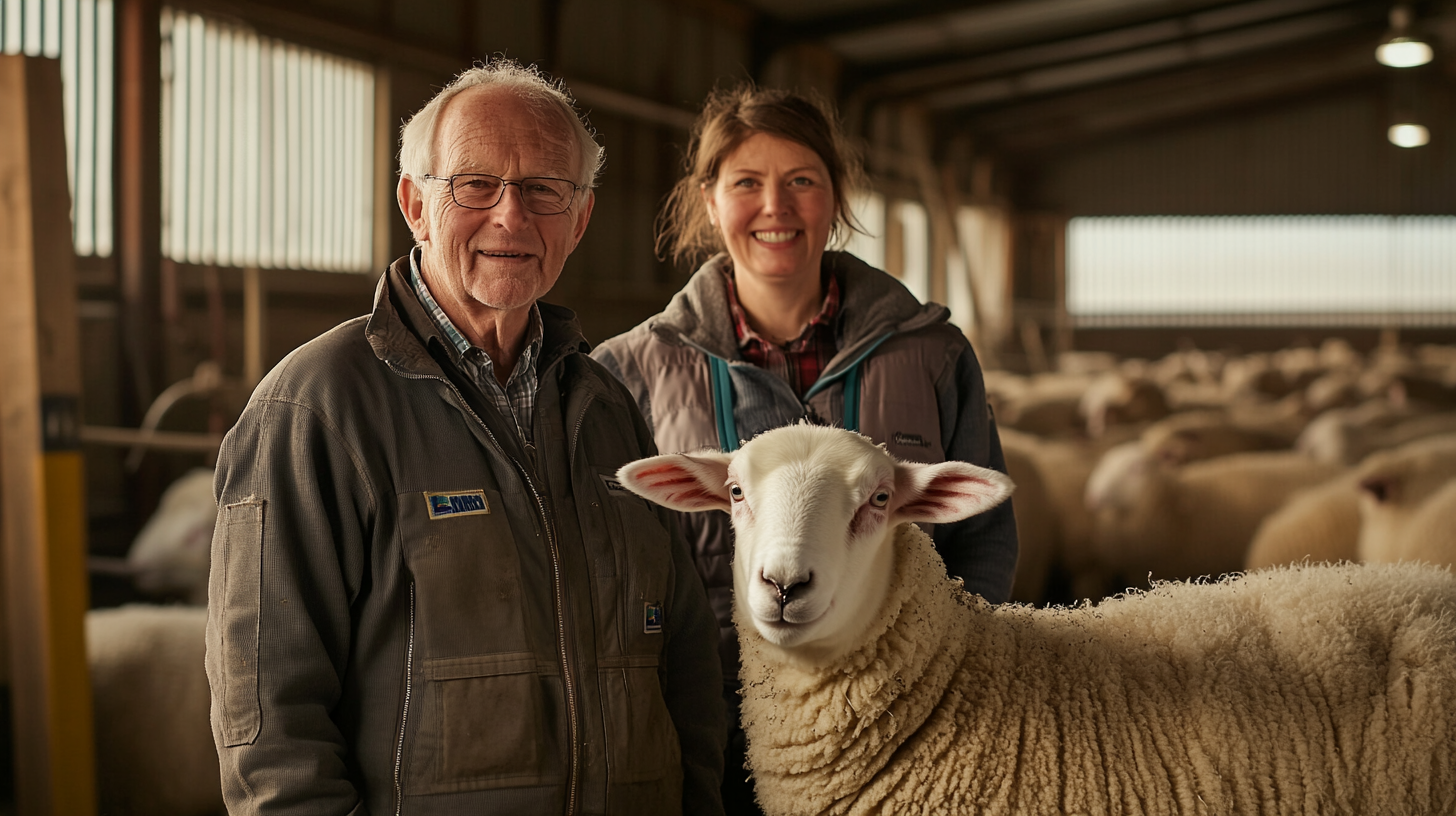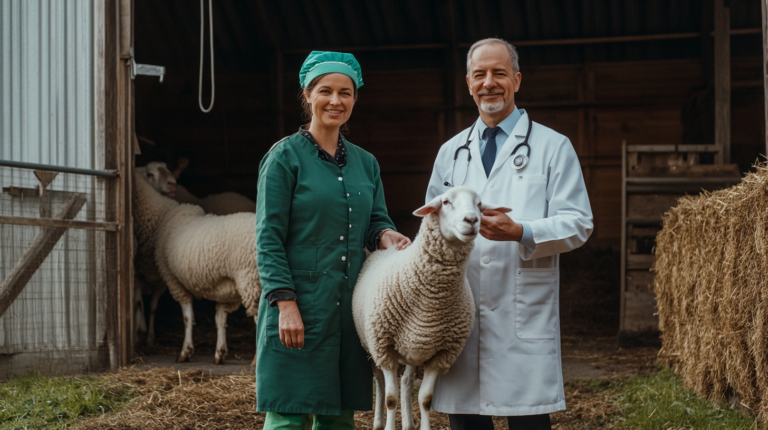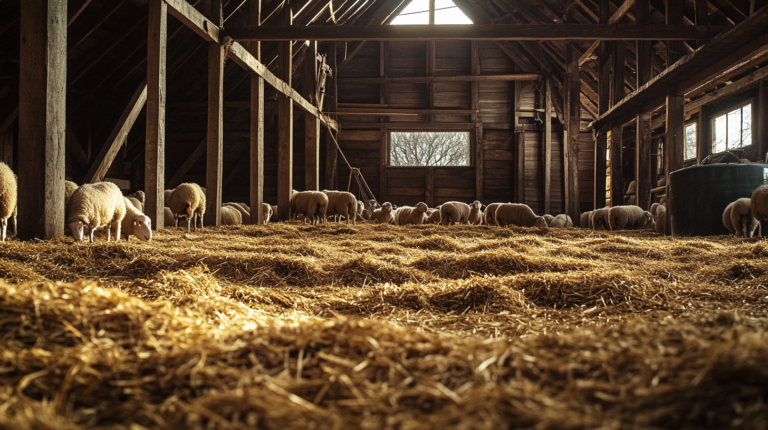Discover the 7 critical warning signs of internal parasites in sheep and learn proven strategies to protect your flock with our comprehensive guide for shepherds.
Table of Contents
Internal parasites represent one of the most significant health challenges facing sheep producers worldwide. These microscopic invaders can quietly devastate a flock’s health and productivity before obvious symptoms appear. Understanding the warning signs of internal parasite infestations and implementing effective preventive strategies is essential for maintaining a healthy, productive flock and ensuring sustainable sheep farming operations.

Introduction
Internal parasites in sheep are a persistent and costly problem for producers across all production systems. These parasites, primarily gastrointestinal nematodes (roundworms), live within the sheep’s digestive tract, feeding on blood, tissue, and nutrients intended for the host animal. Unlike external parasites that can be visually identified, internal parasites often go undetected until significant damage has already occurred.
Recent studies estimate that parasite-related issues cost the global sheep industry billions annually through reduced productivity, treatment expenses, and mortality. According to the American Consortium for Small Ruminant Parasite Control, internal parasites are the primary health concern for small ruminant producers in humid regions, with Haemonchus contortus (barber pole worm) alone causing estimated annual losses exceeding $300 million in the United States.
This comprehensive guide explores the seven critical warning signs of internal parasite infestations in sheep, provides detailed information on identification, prevention, and treatment options, and offers practical strategies to protect your flock from these damaging parasites.
Understanding Internal Parasites in Sheep
Before discussing warning signs, it’s important to understand the major internal parasites affecting sheep and their lifecycle.
Common Internal Parasites in Sheep
- Haemonchus contortus (Barber Pole Worm)
- Blood-sucking parasite found in the abomasum (fourth stomach)
- Causes severe anemia, bottle jaw, and death
- Most problematic in warm, humid environments
- Each adult female can remove up to 0.05ml of blood daily
- Teladorsagia (Ostertagia) circumcincta (Brown Stomach Worm)
- Inhabits the abomasum
- Causes diarrhea, weight loss, and reduced feed efficiency
- Prevalent in cooler, temperate regions
- Trichostrongylus species (Black Scour Worm)
- Affects both the small intestine and abomasum
- Causes black scours (diarrhea), poor growth, and weight loss
- Common in many environments worldwide
- Nematodirus species (Thin-necked Intestinal Worm)
- Inhabits the small intestine
- Primarily affects lambs
- Causes severe diarrhea and rapid weight loss
- Often causes sudden deaths in young animals
- Fasciola hepatica (Liver Fluke)
- Affects the liver
- Causes weight loss, anemia, bottle jaw, and reduced production
- Requires snail intermediate host in wet environments
- Moniezia species (Tapeworms)
- Inhabits the small intestine
- Visible segments in feces
- Generally considered less pathogenic than other parasites
Parasite Lifecycle
Understanding the lifecycle of internal parasites is crucial for implementing effective control strategies:
- Eggs: Adult female worms in the sheep’s digestive tract lay eggs that pass out in the feces.
- Larvae Development: Under favorable conditions (warm, moist environment), eggs hatch into first-stage larvae (L1), then develop into second-stage larvae (L2), and finally into infective third-stage larvae (L3).
- Infection: Sheep ingest L3 larvae while grazing. The L3 larvae then mature into adult worms within the sheep’s digestive system.
- Prepatent Period: The time between ingestion of infective larvae and the appearance of eggs in feces ranges from approximately 17-21 days for most sheep parasites.
- Hypobiosis: Some parasites, particularly Haemonchus and Teladorsagia, can enter a dormant state (arrested development) during unfavorable environmental conditions, reactivating when conditions improve.
This lifecycle knowledge helps producers time treatments and manage pastures effectively to break the parasite cycle.


7 Warning Signs of Internal Parasites in Sheep
Early detection of internal parasite infestations is critical for preventing severe health issues and production losses. Here are the seven key warning signs to watch for:
1. FAMACHA Score Changes and Anemia
One of the most reliable indicators of blood-sucking parasite infection, particularly Haemonchus contortus, is anemia. The FAMACHA© system provides a practical field tool for assessing anemia in sheep by examining the color of the lower eyelid membrane.
How to Check FAMACHA Scores:
- Gently pull down the lower eyelid
- Compare the color to the FAMACHA© card
- Score ranges from 1 (red, not anemic) to 5 (white, severely anemic)
Interpretation:
- Scores 1-2: Minimal to no anemia, typically no treatment needed
- Score 3: Borderline anemia, treatment decision based on other factors
- Scores 4-5: Moderate to severe anemia, treatment typically necessary
Research from the University of Georgia showed that implementing FAMACHA© monitoring reduced anthelmintic use by up to 90% in some flocks while maintaining effective parasite control.
Note: FAMACHA© is specifically designed for detecting blood-feeding parasites and should be used as part of a comprehensive parasite monitoring program.
2. Weight Loss and Poor Body Condition
Unexplained weight loss or failure to gain weight appropriately is a common sign of internal parasite infestation. Parasites compete for nutrients, damage the digestive tract, and can reduce feed intake.
Key Indicators:
- Progressive loss of body condition despite adequate nutrition
- Lambs failing to reach expected growth rates
- Visible signs of thinness, including prominent backbones and ribs
- Uneven weight distribution within the flock (some animals maintaining condition while others decline)
A 2022 study published in Veterinary Parasitology found that moderately parasitized lambs experienced a 15-30% reduction in daily weight gain compared to parasite-free controls, even before clinical signs became apparent.
Monitoring Recommendations:
- Regularly body condition score your flock (1-5 scale)
- Weigh growing lambs every 2-4 weeks
- Track growth patterns to identify individuals or groups falling behind
3. Diarrhea (Scouring)
Persistent diarrhea, often called scouring, is a common sign of several internal parasite infections, particularly those affecting the intestines like Trichostrongylus and Nematodirus species.
Characteristics of Parasite-Related Diarrhea:
- May range from soft pellets to watery feces
- Often dark green to black in color with Trichostrongylus infection
- May contain mucus
- Typically affects multiple animals in similar age groups
- Soiling of wool around the tail area (dag)
Important Distinction: Not all parasites cause diarrhea. Haemonchus contortus, the most pathogenic sheep parasite, typically does not cause diarrhea despite its severe impact on health.
Differential Diagnosis: Diarrhea can be caused by numerous factors besides parasites, including:
- Dietary changes or imbalances
- Bacterial infections (E. coli, Salmonella)
- Viral infections
- Coccidiosis (a protozoan parasite)
- Plant toxicity
Fecal testing is essential to confirm parasite-related diarrhea.
4. Bottle Jaw (Submandibular Edema)
Bottle jaw refers to a soft, fluid-filled swelling under the lower jaw. This condition results from hypoproteinemia (low blood protein levels) caused by blood loss and protein leakage due to parasite damage to the digestive tract.
Key Features:
- Soft, non-painful swelling under the jaw
- More pronounced in the morning, may reduce during the day
- Often accompanied by pale mucous membranes
- Most commonly associated with Haemonchus contortus and liver fluke infections
A study by the University of Kentucky found that sheep with visible bottle jaw typically had worm burdens exceeding 4,000 adult Haemonchus worms and had already lost approximately 15-20% of their blood volume.
Significance: Bottle jaw is a late-stage sign of severe parasite infection and indicates significant health compromise. Animals showing this sign require immediate intervention.
5. Reduced Wool Quality and “Break” in Wool
Parasitic infections create physiological stress that can significantly impact wool production and quality.
Observable Changes:
- Reduced wool growth rate
- “Break” in the wool (weak point in the fiber where it easily breaks)
- Dull, lustreless appearance
- Increased fiber diameter variation
- Poor staple strength
Research from Australia’s CSIRO demonstrated that even subclinical parasite burdens can reduce wool production by 10-15%, with fiber strength reduced by up to 25% during peak infection periods.
Economic Impact: The wool quality changes caused by parasites can substantially reduce the value of the wool clip, adding to the economic burden of parasitism beyond just health impacts.
6. Reduced Reproductive Performance
Internal parasites can have significant negative effects on reproduction in both ewes and rams.
Effects in Ewes:
- Delayed estrus or failure to cycle
- Reduced conception rates
- Increased embryonic mortality
- Lower birth weights
- Reduced milk production and quality
- Higher lamb mortality
Effects in Rams:
- Decreased libido
- Reduced sperm quality and quantity
- Lower serving capacity
A comprehensive New Zealand study found that ewes with moderate parasite burdens produced 15% less milk and had lambs that were on average 0.8 kg lighter at weaning compared to ewes with low parasite burdens.
Long-term Consequences: Reproductive inefficiencies due to parasitism compound over time, significantly reducing lifetime productivity of breeding stock and overall flock performance.
7. Lethargy and Changes in Behavior
Behavioral changes can be subtle early indicators of parasite burden before more obvious clinical signs appear.
Observable Behavioral Changes:
- Reduced grazing time
- Isolation from the flock
- Standing with head down
- Reluctance to move
- Lagging behind during movement
- Spending more time lying down
- Reduced response to normal stimuli
Researchers at North Carolina State University documented that sheep with significant parasite burdens spent approximately 18% less time grazing and 32% more time resting compared to sheep with minimal parasite loads.
Importance of Observation: Regular observation of flock behavior can help identify affected animals early. Behavioral changes may precede physical symptoms by several days to weeks.
Diagnostic Methods for Internal Parasites
Accurate diagnosis is essential for implementing targeted treatment and control strategies.
Fecal Egg Count (FEC)
The gold standard for diagnosing internal parasite infections is the fecal egg count (FEC), which quantifies the number of parasite eggs per gram of feces.
Procedure:
- Collect fresh fecal samples from individual sheep or representative group samples
- Process samples using flotation technique
- Count eggs under microscope using McMaster slide or similar method
- Results expressed as eggs per gram (EPG) of feces
Interpretation Guidelines:
- <500 EPG: Low infection level
- 500-2000 EPG: Moderate infection level
- 2000 EPG: High infection level
Limitations:
- Egg counts don’t always correlate directly with actual worm burden
- Immature worms don’t produce eggs but can cause disease
- Different parasites have different egg-laying patterns
- Seasonal variations affect results
Fecal Egg Count Reduction Test (FECRT)
This test evaluates the effectiveness of dewormers by comparing egg counts before and after treatment.
Procedure:
- Conduct baseline FEC
- Administer dewormer to test group
- Conduct follow-up FEC 10-14 days post-treatment
- Calculate percentage reduction in egg count
Interpretation:
- 95% reduction: Effective treatment
- 90-95% reduction: Suspected resistance developing
- <90% reduction: Significant resistance present
Post-Mortem Examination
While not practical for routine monitoring, examining the digestive tract of deceased sheep can provide valuable information about parasite types and burden.
Focus Areas:
- Abomasum for Haemonchus and Teladorsagia
- Small intestine for Trichostrongylus and Nematodirus
- Liver for Fasciola hepatica
- Large intestine for nodule worms
Preventive Strategies and Management Practices
Effective parasite control requires an integrated approach combining management practices, strategic treatment, and monitoring.
Pasture Management
Proper pasture management is a cornerstone of sustainable parasite control.
Rotational Grazing:
- Move sheep to clean pastures every 3-4 days
- Rest pastures for at least 60 days when possible
- Implement leader-follower systems with less susceptible species (cattle or horses)
Stocking Density:
- Maintain appropriate stocking rates
- Avoid overgrazing, which forces sheep to graze closer to parasite-laden feces
- Research from Massey University showed that reducing stocking density by 25% decreased parasite burden by up to 50% in some environments
Pasture Height:
- Maintain minimum pasture height of 4-6 inches
- Most infective larvae remain in the bottom 2 inches of forage
- Taller grazing significantly reduces parasite exposure
Mixed Species Grazing:
- Alternate or co-graze with cattle or horses
- Most sheep parasites cannot complete lifecycle in cattle and vice versa
- Studies show mixed grazing can reduce parasite loads by 30-50%
Strategic Deworming
Targeted selective treatment approaches focus on treating only animals that need it rather than whole-flock treatment.
Implementing the Five Point Check©:
- Eye (FAMACHA© score for anemia)
- Back (body condition score)
- Tail (dag score/diarrhea)
- Jaw (bottle jaw)
- Nose (nasal discharge, relevant for some respiratory parasites)
Strategic Timing:
- Treat before key stress periods (lambing, breeding)
- Treat during peak parasite seasons based on local epidemiology
- Avoid treating during drought periods when pasture refugia is limited
Smart Drenching Principles:
- Use full recommended dose based on weight
- Withhold feed 12-24 hours before treatment with benzimidazoles
- Rotate to clean pasture 4-7 days after treatment, not immediately
- Use combination products when resistance is suspected
Genetic Selection for Parasite Resistance
Breeding for parasite resistance offers a sustainable long-term solution.
Selection Criteria:
- Track and select breeding stock with consistently low FEC
- Use estimated breeding values (EBVs) for parasite resistance when available
- Consider breed differences in parasite resistance (e.g., hair sheep breeds like St. Croix and Katahdin typically show greater resistance)
Heritability: Research indicates moderate heritability (0.2-0.4) for parasite resistance traits, making genetic progress possible through consistent selection.
Implementation Timeline:
- Short-term: Cull consistently susceptible animals
- Medium-term: Select rams with demonstrated resistance
- Long-term: Establish breeding program with parasite resistance as a key selection trait
Nutritional Management
Proper nutrition enhances the sheep’s natural immunity to parasites.
Protein Supplementation:
- Increase dietary protein (especially during stress periods)
- Studies show that increasing crude protein by 2-4% above maintenance requirements can enhance immune response to parasites
- Particularly beneficial for periparturient ewes and growing lambs
Trace Minerals:
- Ensure adequate copper, zinc, selenium, and cobalt
- These minerals play crucial roles in immune function
- Consider strategic mineral supplementation during high-risk periods
Energy Balance:
- Maintain appropriate energy intake
- Negative energy balance impairs immune function
- Supplement energy during high-demand periods (late gestation, early lactation)
Bioactive Forages and Alternatives
Certain plants contain compounds that may reduce parasite impacts.
Tannin-Rich Forages:
- Chicory, birdsfoot trefoil, sainfoin, sulla, sericea lespedeza
- Contain condensed tannins that can reduce parasite egg production and larval development
- Research shows 30-70% reduction in FEC when tannin-rich forages comprise >30% of diet
Other Natural Approaches:
- Copper oxide wire particles (COWP)
- Diatomaceous earth (limited scientific evidence)
- Nematophagus fungi (Duddingtonia flagrans)
- Essential oils (research ongoing)
Quarantine and Biosecurity
Preventing parasite introduction is easier than managing established problems.
New Animal Protocol:
- Isolate all new animals for at least 30 days
- Perform FEC upon arrival
- Treat with multiple dewormer classes sequentially
- Perform follow-up FEC to confirm effectiveness
- Only introduce to flock after confirmed clean status
Visitor Protocols:
- Limit unnecessary traffic between flocks
- Provide boot washing/covering for visitors
- Keep equipment separate between flocks when possible
Treatment Options and Anthelmintic Classes
When treatment becomes necessary, understanding the available options is crucial.
Major Anthelmintic Classes
- Benzimidazoles (White Drenches)
- Examples: albendazole, fenbendazole, oxfendazole
- Mode of action: Inhibit microtubule formation
- Spectrum: Broad spectrum, including adult and larval stages
- Notes: Widespread resistance reported globally
- Imidazothiazoles/Tetrahydropyrimidines (Yellow Drenches)
- Examples: levamisole, morantel
- Mode of action: Nicotinic acetylcholine receptor agonists
- Spectrum: Effective against adult worms but limited efficacy against arrested larvae
- Notes: Narrower safety margin than other classes
- Macrocyclic Lactones (Clear Drenches)
- Examples: ivermectin, moxidectin, doramectin
- Mode of action: Chloride channel modulators
- Spectrum: Broad spectrum, including external parasites
- Notes: Persistent activity with some products; resistance increasing
- Amino-Acetonitrile Derivatives (Orange Drenches)
- Example: monepantel
- Mode of action: Nicotinic acetylcholine receptor modulator
- Spectrum: Broad spectrum against gastrointestinal nematodes
- Notes: Newer class, but resistance already reported in some regions
- Spiroindoles (Purple Drenches)
- Example: derquantel (in combination with abamectin)
- Mode of action: Nicotinic acetylcholine receptor antagonist
- Spectrum: Broad spectrum when used in combination
- Notes: Only available in combination products
Combination Products
Using products containing multiple active ingredients from different classes:
- Increases efficacy
- Slows resistance development
- Provides broader spectrum of activity
- Examples include combinations of abamectin+levamisole, abamectin+derquantel
Anthelmintic Resistance Management
Parasite resistance to dewormers is a global crisis in sheep production. Strategies to manage resistance include:
Refugia-Based Approaches:
- Maintain untreated population of parasites to dilute resistant genes
- Leave 10-20% of animals untreated
- Avoid treating during drought when few parasites are on pasture
Proper Dosing:
- Weigh animals before treatment
- Dose for the heaviest animal in the group
- Ensure proper administration technique
Targeted Selective Treatment:
- Only treat animals showing clinical signs or poor performance
- Use objective criteria like FAMACHA©, body condition, and FEC
Regular Efficacy Testing:
- Perform FECRT every 1-2 years
- Switch classes when efficacy drops below 95%
- Consider larval development assays for more detailed resistance profiling
Special Considerations for Different Production Stages
Parasite control strategies should be tailored to different life stages and production cycles.
Pregnant and Lactating Ewes
The periparturient period (late pregnancy through early lactation) presents unique challenges:
Periparturient Rise:
- Temporary suppression of immunity leads to increased worm burden
- Egg counts can increase 2-8 fold during this period
- Major source of pasture contamination and infection for lambs
Management Strategies:
- Strategic treatment 2-4 weeks before lambing
- Provide high protein supplementation (16-18% crude protein)
- Lamb on clean pastures when possible
- Consider FAMACHA© monitoring every 2 weeks during lactation
Growing Lambs
Young animals are particularly vulnerable to parasite challenges:
Age-Based Susceptibility:
- Immunity develops gradually between 4-12 months of age
- Lambs under 6 months are highly susceptible
- Growth impacts can be substantial even with moderate infections
Protection Strategies:
- Wean to clean pastures
- Implement creep grazing systems allowing lambs access to clean pasture ahead of ewes
- Consider more frequent monitoring (every 2-3 weeks)
- Prioritize nutrition to support both growth and immune development
Flock-Wide Annual Planning
Develop a calendar-based approach tailored to your specific region and production system:
Annual Planning Elements:
- Map high vs. low-risk pastures
- Schedule strategic treatments based on local epidemiology
- Plan pasture rotations to minimize exposure
- Schedule monitoring events (FAMACHA©, FEC)
- Document results to track changes over time
Recommended Products for Internal Parasite Management
Diagnostic Tools
- FAMACHA© Anemia Guide Card – Essential tool for field assessment of anemia in sheep
- McMaster Fecal Egg Counting Kit – Complete kit for on-farm parasite monitoring
- Digital Livestock Scale – Accurate weight measurement ensures proper dosing and monitors growth impacts
- Body Condition Scoring Guides – Laminated cards for consistent body condition assessment
Frequently Asked Questions
How often should I deworm my sheep?
Deworming should be based on need rather than a fixed schedule. Implement monitoring tools like FAMACHA© scoring, body condition assessment, and periodic fecal egg counts to determine which animals require treatment. Many successful producers have reduced treatment frequency to 2-3 times per year or less using targeted selective treatment approaches.
Which dewormer is best for sheep?
The “best” dewormer depends on your specific parasite challenges and local resistance patterns. Ideally, perform a fecal egg count reduction test to determine which products are effective in your flock. Rotating between different drug classes or using combination products containing multiple active ingredients is generally recommended to slow resistance development.
Can I use natural alternatives instead of chemical dewormers?
While some natural approaches show promise, most currently lack the consistent efficacy of conventional dewormers in clinical cases. Tannin-rich forages like sericea lespedeza, copper oxide wire particles, and certain condensed tannin products can reduce parasite loads but are generally most effective as part of an integrated program rather than as standalone treatments for clinical cases.
How do I know if my sheep have internal parasites?
Signs of internal parasitism include anemia (pale mucous membranes), weight loss despite adequate nutrition, diarrhea, bottle jaw (swelling under the jaw), rough or poor-quality wool, lethargy, and reduced production. Definitive diagnosis requires fecal egg counting or post-mortem examination.
Can I completely eliminate internal parasites from my flock?
Complete elimination is neither practical nor desirable. The goal should be to manage parasite levels to minimize health and production impacts while preventing the development of drug resistance. Some level of parasite exposure is actually beneficial for developing natural immunity in the flock.
How do weather conditions affect parasite levels?
Warm, humid conditions generally favor parasite development and survival. Eggs develop into infective larvae faster in warm temperatures (optimal 70-85°F), while moisture is essential for larval migration up grass blades. Drought conditions typically reduce parasite pressure temporarily, while wet seasons increase risk. However, specific patterns vary by parasite species and region.
At what age do lambs become resistant to internal parasites?
Lambs begin developing immunity to internal parasites around 4-6 months of age, with significant protection typically evident by 10-12 months. However, the development of immunity requires controlled exposure to parasites and adequate nutrition. Even adult sheep can experience compromised immunity during stress periods like late pregnancy and early lactation.
Expert Tips for Sustainable Parasite Management
- Know Your Enemy – Identify which parasites are problematic in your specific region and flock through testing and working with local veterinarians or extension specialists.
- Monitor Before Treating – Implement regular monitoring using FAMACHA©, body condition scoring, and strategic fecal egg counts to make evidence-based treatment decisions.
- Embrace Genetic Solutions – Actively select for parasite resistance in your breeding program by retaining animals that consistently demonstrate resilience.
- Think Long-Term – Focus on sustainable management rather than quick fixes. Short-term convenience often leads to long-term problems with resistant parasites.
- Leverage Your Environment – Work with natural cycles and seasonal patterns specific to your region to time interventions when they’ll be most effective.
Conclusion
Internal parasites represent one of the most significant challenges in sheep production, but with a systematic approach to monitoring, management, and strategic treatment, producers can effectively protect their flocks while maintaining sustainable production systems.
By recognizing the seven warning signs of parasite infestation—anemia, weight loss, diarrhea, bottle jaw, wool quality changes, reproductive issues, and behavioral changes—producers can intervene before severe production losses occur. Implementing integrated control strategies that combine pasture management, selective treatment, genetic selection, and nutrition will yield the best long-term results.
Remember that parasite control is not about elimination but about maintaining a balance that keeps parasite impacts below economic thresholds while preserving treatment efficacy for future use. With consistent attention and a systematic approach, internal parasites can be effectively managed to ensure flock health and productivity.
For more expert recommendations and in-depth guides on sheep health and management, visit BlithePet





